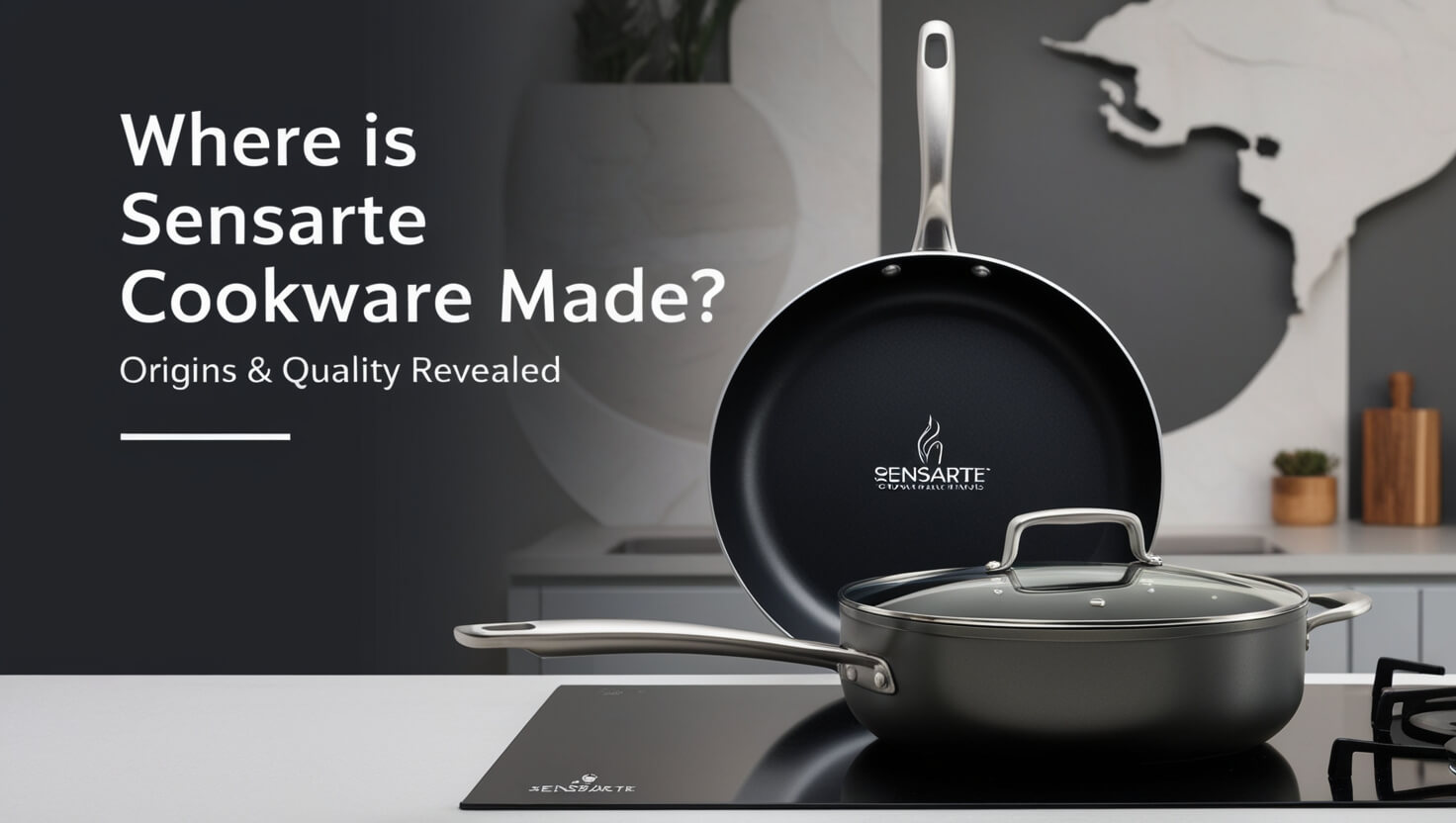
Sensarte makes most of its cookware in China, with some parts from other places. Folks like this brand because it’s good and cheap. Want to know more? We’ll check out how they make their pots and pans, what goes into them, and how they keep things nice.
The Origins of Sensarte Cookware
Brief History of Sensarte
Sensarte burst onto the cookware scene in 2001, aiming to blend quality with affordability. The company quickly made a name for itself by offering innovative designs and durable products. From its inception, Sensarte focused on creating cookware that could compete with high-end brands without the hefty price tag.
Sensarte’s Manufacturing Philosophy
At the heart of Sensarte’s approach is a commitment to quality and innovation. The brand believes in combining traditional craftsmanship with modern technology. This philosophy shapes every aspect of their production process, from design to final quality checks.
Sensarte Cookware Production Locations
Main Manufacturing Facilities
While Sensarte’s headquarters are in the United States, the bulk of their cookware production happens in China. This choice allows the company to keep costs down while maintaining control over the manufacturing process. The Chinese facilities are equipped with state-of-the-art machinery and staffed by skilled workers.
Sourcing of Materials
Sensarte doesn’t rely solely on Chinese materials. The company sources some components from other countries to ensure the best quality. For example, the non-stick coating used in many Sensarte products is imported from Switzerland, known for its high-quality materials.
The Manufacturing Process of Sensarte Cookware
Design and Engineering
Before a Sensarte pan ever reaches a stovetop, it goes through rigorous design and engineering phases. The process starts in the U.S., where designers and engineers work together to create products that meet the needs of modern cooks. They focus on factors like heat distribution, durability, and ease of use.
Production Techniques
Once designs are finalized, production begins in China. Sensarte uses a mix of traditional and cutting-edge techniques. The cookware bodies are typically made through a die-casting process, which ensures uniform thickness and durability. The non-stick coating is applied using advanced spraying techniques for even coverage.
Quality Control Measures
Sensarte implements strict quality control at every stage of production. Each piece of cookware undergoes multiple inspections before it’s approved for packaging. This attention to detail helps maintain the brand’s reputation for reliability.
Materials Used in Sensarte Cookware
Body Construction
Most Sensarte cookware features a body made from die-cast aluminum. This material is chosen for its excellent heat conductivity and lightweight nature. The aluminum core ensures even heat distribution, crucial for consistent cooking results.
Non-stick Coating
The star of Sensarte’s cookware is often its non-stick coating. Imported from Switzerland, this PFOA-free coating is known as ILAG. It’s applied in multiple layers to ensure durability and excellent food release properties. The use of this high-quality coating sets Sensarte apart from many budget cookware brands.
Handles and Lids
Sensarte pays special attention to the ergonomics of their cookware. Handles are typically made from heat-resistant bakelite, often featuring a wood-grain design for a comfortable grip. Lids are usually tempered glass, allowing cooks to monitor their food without lifting the lid.
Sensarte’s Commitment to Quality
Industry Standards and Certifications
Sensarte cookware meets various industry standards and holds several certifications. Their products are often SGS approved, ensuring they meet strict quality and safety guidelines. The non-stick coatings are PFOA-free, addressing health concerns associated with some older non-stick technologies.
Environmental Considerations
While Sensarte doesn’t heavily market itself as an eco-friendly brand, they do take steps to minimize their environmental impact. The use of durable materials means their cookware lasts longer, reducing waste. Additionally, their efficient manufacturing processes help reduce energy consumption.
Comparing Sensarte to Other Cookware Brands
Manufacturing Locations of Competitors
Many of Sensarte’s competitors also manufacture in China, making it a common practice in the industry. However, some high-end brands produce their cookware in countries like France, Germany, or the United States. These brands often come with a significantly higher price tag.
Quality and Price Comparisons
When compared to other brands in its price range, Sensarte often stands out for its quality. The use of Swiss non-stick coating and careful manufacturing processes results in cookware that performs well above its price point. However, it may not match the longevity of some premium brands that use materials like stainless steel or copper.
The Impact of Manufacturing Location on Cookware Quality
Advantages of Sensarte’s Production Choices
By manufacturing in China, Sensarte can offer high-quality cookware at competitive prices. The country’s well-developed manufacturing infrastructure and skilled workforce contribute to efficient production. This allows Sensarte to invest more in quality materials, like the Swiss non-stick coating, without drastically increasing costs.
Potential Drawbacks
Some consumers may have concerns about cookware made in China. However, Sensarte’s strict quality control measures help address these worries. The brand’s transparency about their manufacturing locations and material sourcing also builds trust with customers.
Sensarte Cookware Product Range
Popular Sensarte Collections
Sensarte offers a wide range of cookware to suit different cooking needs. Their product line includes frying pans, saucepans, stockpots, and complete cookware sets. The Granite Stone collection, featuring a speckled non-stick surface, is particularly popular among home cooks.
Specialized Products
Beyond basic cookware, Sensarte also produces specialized items. These include woks for Asian cuisine, grill pans for indoor grilling, and deep fryers. Each product is designed with specific cooking techniques in mind, showcasing Sensarte’s commitment to versatility.
Caring for Your Sensarte Cookware
Proper Use and Maintenance
To get the most out of Sensarte cookware, proper care is essential. The company recommends using low to medium heat settings to preserve the non-stick coating. They also advise against using metal utensils, which can scratch the cooking surface. Hand washing is preferred over dishwasher cleaning to extend the life of the cookware.
Extending the Lifespan of Your Cookware
With proper care, Sensarte cookware can last for years. Avoid sudden temperature changes, which can warp the pan. Regularly seasoning the cooking surface can help maintain its non-stick properties. Storing the cookware properly, using pan protectors if stacking, can prevent scratches and dents.
Customer Experiences with Sensarte Cookware
Reviews and Testimonials
Many customers praise Sensarte cookware for its performance and value. Common positive feedback includes appreciation for the effective non-stick properties and even heat distribution. The aesthetic appeal of the cookware, especially the Granite Stone collection, is often mentioned in reviews.
Common Praises and Concerns
While most reviews are positive, some users report that the non-stick properties decrease over time. This is a common issue with all non-stick cookware and can often be mitigated with proper care. Some customers also mention that the pans are lighter than expected, which can be seen as a pro or con depending on personal preference.
Frequently Asked Questions About Sensarte Cookware
Is Sensarte cookware made in the USA?
While Sensarte is an American company, their cookware is primarily manufactured in China.
Where does Sensarte source its materials?
Sensarte sources materials from various countries. The non-stick coating, for example, is imported from Switzerland.
Are Sensarte products safe to use?
Yes, Sensarte cookware meets industry safety standards. Their non-stick coatings are PFOA-free and SGS approved.
Is Sensarte cookware oven-safe?
Most Sensarte cookware is oven-safe up to 302°F (150°C). Always check the product specifications for exact temperature limits.
Can I use Sensarte cookware on an induction cooktop?
Yes, Sensarte cookware is compatible with all stovetops, including induction.
How long does the non-stick coating last?
With proper care and use, the non-stick coating can last for several years. However, all non-stick coatings will eventually wear down with use.
Conclusion
Sensarte cookware, while primarily made in China, represents a global approach to manufacturing. By combining Chinese production capabilities with Swiss coating technology and American design, Sensarte creates cookware that balances quality and affordability. The brand’s transparency about its manufacturing processes and commitment to quality control have helped it build a loyal customer base.
For consumers wondering where Sensarte cookware is made, the answer goes beyond a simple location. It’s about understanding the thought and effort that goes into each piece, from design to production to quality assurance. Whether you’re a seasoned chef or a cooking novice, Sensarte offers cookware that aims to enhance your culinary experience without breaking the bank.






